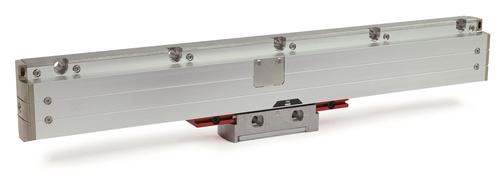Sensor's Resolution Is Less Than the Diameter of an Atom
A new linear encoder will offer measurement resolution of about 31 picometers -- less than the diameter of an atom -- when it hits the market in prototype form later this year.
September 23, 2016
A new linear encoder will offer measurement resolution of about 31 picometers (pm) -- less than the diameter of an atom -- when it hits the market in prototype form later this year.
Previewed at the International Manufacturing Technology Show (IMTS 2016) last week, the LP 100 encoder promises to have a resolution of 31.25 pm (31 x 10-12 meters). By comparison, an atom typically ranges from about 100 to 500 pm. Heidenhain Corp., maker of the new encoder, says the technology will be applicable to diamond turning machinery, lens manufacturing, and jig grinding applications.

Heidenhain’s LP 100 linear encoder offers a measurement resolution of 31 picometers. (Source: Heidenhain Corp.)
”If you want a high-end surface finish -- a mirror finish -- for a high-end lens, this is the best technology,” Thomas Wyatt, marketing manager for Heidenhain, said at the show. “Even some metal parts may require this kind of high surface quality.”
Heidenhain believes the 31-pm resolution is the best in the world. "Others have done one nanometer (1 x 10-9 m), but we are not aware of anything like this,” Wyatt said.
The LP 100 is an incremental unguided linear encoder that is suitable for applications ranging in length from 140 mm to 3,040 mm. Today, it travels at speeds of 90 m/minute, but the company says it plans to double that speed in the near future.
READ MORE ABOUT ADVANCED MANUFACTURING:
Heidenhain declined to explain what makes their encoder’s resolution so much better, other than to say its light source offers greater position stability. The LP 100 employs interferometric technology, which is not uncommon.
Linear encoders are used in a multitude of applications, ranging from metrology instruments to motion systems to high-precision machine tools, including CNC mills and coordinate measurement systems. The LP 100, however, will have a narrower list of potential applications.
The company said it currently has two prototype systems in use with unnamed customers. Most of the early applications will be customer-specific, Wyatt said. “This was done at a customer’s request,” he said. “It’s a very limited market size, but it’s something that we’re glad to do.”
Senior technical editor Chuck Murray has been writing about technology for 32 years. He joined Design News in 1987, and has covered electronics, automation, fluid power, and autos.
About the Author(s)
You May Also Like



